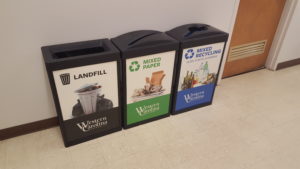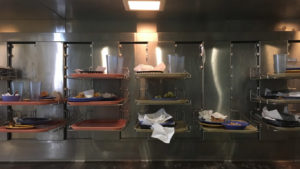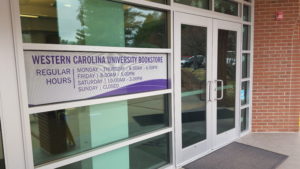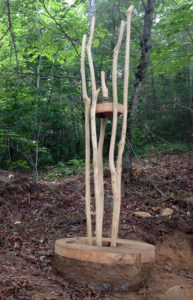
WCU new recycling bins found in Killian and Stillwell buildings. Photo by Rachel Plouse.
Story was co-written/ produced with Matt Ober.
What do hog farms, biofuels, recycling bins, and Energy Star certifications have in common? They’re all a part of the sustainability efforts on the WCU campus.
Environmental sustainability is the ability for resources to be sustained or supported. By becoming a sustainable campus, students and faculty at WCU are doing their best to not be harmful to the environment or depleting natural resources.
Unknown by many WCU students, many of the recycling efforts by WCU contribute to local

Food waste in the dining hall after a lunch rush. Photo by Lucy Jones.
businesses around Jackson County. All food waste generated during both meal preparation and left over by consumers is given to a local hog farm as food for the animals. This program has been around since the 1970’s when WCU first started sustainability initiatives. Other waste contributed by food preparation such as waste cooking oil is collected by Blue Ridge Biofuels, a local business, and turned into bio-diesel and home heating oil.
Other waste is recycled the old-fashioned way with brand new recycling bins. These new bins can be found in only Killian and Stillwell buildings, but the Office of Sustainability and Energy Management hopes to continue putting them in the rest of the buildings on campus. Classrooms in those buildings have had the trashcans removed, requiring students to put trash in marked bins in every hall.
“I think people view recycling now as a habit and it’s been normalized in society, but you have to make sure they have the convenience,” said Lauren Bishop, Chief Sustainability Officer and Director of Sustainability and Energy Management at WCU.
With a new recycling coordinator, grants for new recycling bins, and programs like the WHEE Recycle Tailgate Recycling program, WCU’s recycling volume has increased by 85 percent in the last five years and continues to increase.
Recycling isn’t the only cog in the sustainability machine. WCU also continues to reduce energy usage by installing new LED lighting throughout the campus and taking strides in water conservation.
“This year we’ve reduced our energy usage by 40 percent,” said Bishop.

WCU bookstore that recently received a Energy Star certification. Photo by Rachel Plouse
Part of the drop-in usage can be attributed to the recent Energy Star certification achieved by the University Bookstore this past year. This certification is obtained by using less energy per square foot than 75 percent of similar building stock. This is currently the only building on campus with this certification.
They aren’t stopping there. The recently updated Strategic Energy Plan for the 2016-2017 school year, provided by Bishop, lists many ambitious sustainability objectives. These include continued integration of new condensate meters (electronic meters that track energy usage by building in real time) across campus, re-tuning air handler units, and creating building controls specification. All of these help save energy and cut university costs.
David King, Energy Management Specialist at WCU, said that even though our Sustainability and Energy Management Department is small, they are coming up with more and more ways to save energy every day.
The key to becoming a leading school in sustainability is getting students involved. The Sustainable Environment Initiative Committee is a group of faculty and students that make decisions regarding sustainable projects on campus. According to Joseph Guseman, Chair of SEI, $5 comes out of every student’s tuition and into the SEI budget. This money is used for project such as the Electron Garden on the Green (EGG), a solar powered hammock lounge designed by three WCU students. Click here to read Maintaining a green campus by Lucy Jones.

The Dirtmaker on the WCU trail. Photo provided by the SEI committee.
SEI’s projects help to educate students, faculty, and campus visitors about the environment and sustainable energy. With the help of artists from Camp Little Hope, SEI funded the Dirtmaker project which can be found on the WCU hiking trail system. The Dirtmaker is a permanent interactive sculpture that replenishes minerals in the forest soil when rocked back and fort.
Even with students involved, environmental sustainability can only go so far. Bishop said that current human attitudes and behavior limits success. She explained that it’s a bell curve, with the environmentally conscious on one side, those who don’t care on the other, and the apathetic middle in between. Educating the community and promoting the awareness is vital to helping sustainability progress.
“Getting folks to that AHA moment where they realize that climate change is real, that’s the key to reaching the apathetic middle,” said Bishop.
Watch below for student opinions of WCU’s sustainability efforts.



